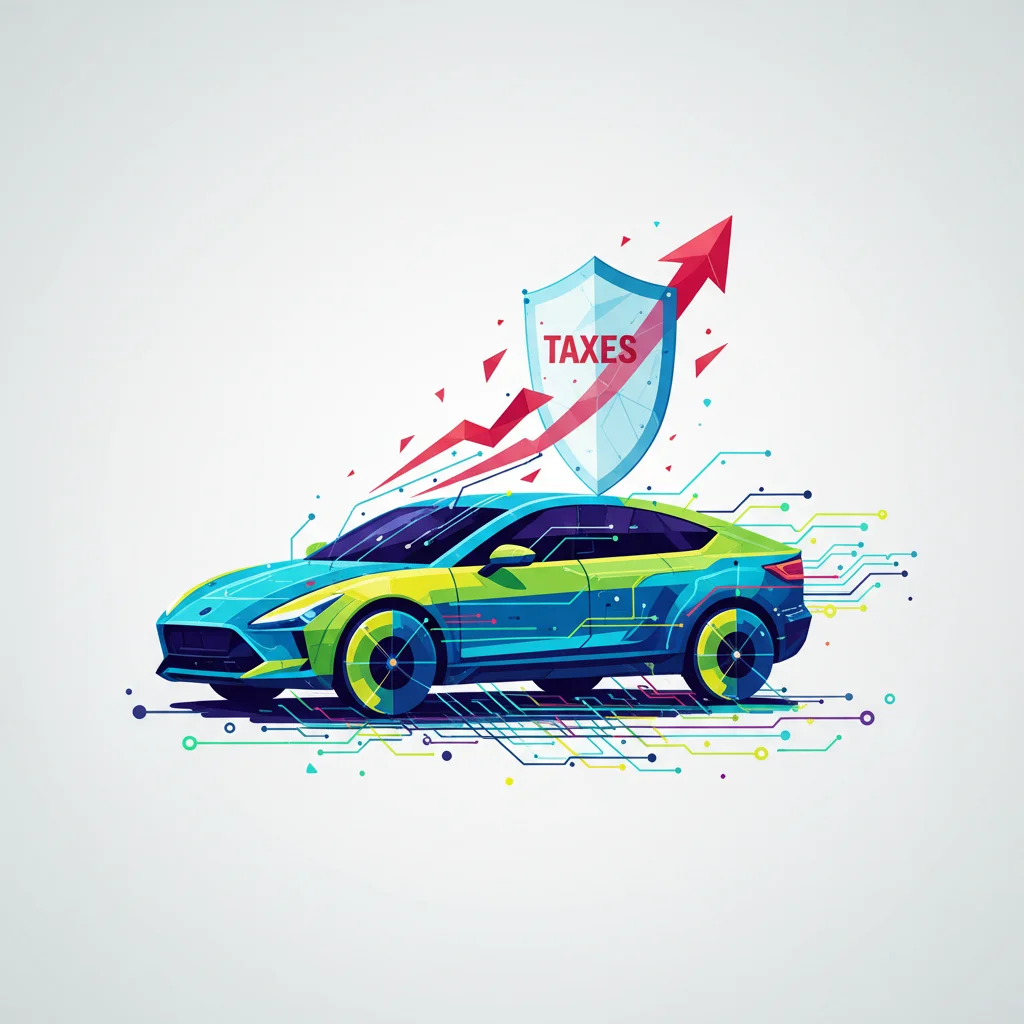
Don’t Tax Innovation: Why the Future of Electric Vehicles is a Software-Defined Problem
In the high-stakes race to electrify our roads, a surprising warning sign has just flashed on the dashboard. Lisa Brankin, the head of Ford in the UK, has made a stark declaration: it is emphatically “not the right time” to start taxing electric vehicles (EVs). Her reasoning is simple and direct: consumer demand, once accelerating at a thrilling pace, has begun to stall. This isn’t just a headline from the automotive world; it’s a critical signal for the entire tech ecosystem—from cloud architects and AI developers to SaaS entrepreneurs and cybersecurity experts. The challenges facing the EV transition are no longer just about building better batteries or more efficient motors. They are about building a smarter, more integrated, and software-defined ecosystem. Slapping a tax on the hardware right now is like trying to fix a complex software bug by hitting the monitor.
The Crossroads of Adoption: Why Are We Stalling?
To understand why a new tax could be so detrimental, we first need to diagnose why the EV adoption curve is flattening. While early adopters eagerly embraced the new technology, the mainstream consumer is proving to be a more cautious customer. The reasons are a complex mix of economic, logistical, and psychological barriers.
According to the latest industry data, while EV sales are still growing, the rate of that growth has slowed significantly. The Society of Motor Manufacturers and Traders (SMMT) reported that while battery electric vehicle registrations were up in early 2024, their market share has remained stagnant at around 16% for over a year (source). Ford’s UK boss points a finger at this trend, arguing that we haven’t yet reached the tipping point where the market can sustain itself without incentives. The primary hurdles for the average car buyer remain:
- High Upfront Cost: Despite falling battery prices, EVs still carry a significant price premium over their internal combustion engine (ICE) counterparts. Government incentives have helped bridge this gap, but as they are phased out, the sticker shock becomes more pronounced.
- Charging Infrastructure Anxiety: The fear of being stranded with a dead battery is real. While the number of charging points is growing, the network is perceived as fragmented, unreliable, and often inconvenient, especially for those without private driveways.
- Range and Charging Speed: While modern EVs offer impressive range, cold weather can significantly reduce it. Furthermore, the time it takes to “refuel” is still orders of magnitude longer than a 5-minute stop at a petrol station.
These aren’t just automotive problems. They are complex systems-level challenges that require innovative, technology-driven solutions. Premature taxation ignores this complexity, treating a multifaceted issue with a blunt instrument.
The Government’s Dilemma: Plugging Fiscal Holes vs. Fueling an Industry
From a policymaker’s perspective, the move towards EVs creates a looming fiscal black hole. For decades, fuel duty has been a reliable and substantial source of government revenue, funding everything from road maintenance to public services. As cars switch from petrol and diesel to electricity, that revenue stream evaporates. The UK Treasury, for instance, faces losing tens of billions of pounds annually. This has led to discussions about a new system of road pricing or a specific tax on EVs to make up for the shortfall, as Brankin noted in her comments to the BBC.
The challenge is one of timing. Introducing a tax now would add another financial barrier for consumers who are already on the fence, effectively punishing them for making a greener choice. It sends a mixed message: “We want you to buy EVs, but we’re going to make it more expensive.”
Let’s look at a simplified comparison of the financial pressures at play:
| Factor | Legacy System (ICE Vehicles) | Emerging System (EVs) | The Policy Challenge |
|---|---|---|---|
| Primary Revenue Source | Fuel Duty & Vehicle Excise Duty (VED) | Currently Low/No VED, No Fuel Duty | Replace billions in lost fuel duty revenue without killing the market. |
| Consumer Incentive | None (Taxed heavily) | Lower running costs, tax exemptions | Maintain incentives long enough to reach mass adoption. |
| Infrastructure Funding | Partially funded by fuel duty | Public/private investment, grants | Spur private investment in a robust national charging network. |
The Tech Industry’s Playbook: Reframing the EV Challenge
The solution to the EV stall isn’t a new tax; it’s a new wave of innovation. This is where the world of software, AI, and cloud computing becomes the engine of progress. The hurdles of cost, range, and infrastructure are precisely the kinds of problems that the tech industry excels at solving through smart, scalable systems.
From Product to Platform: The Power of SaaS and Cloud
The current charging experience is broken. Different providers, different apps, different payment systems. Imagine if every website required a different browser. This is a classic platform problem waiting for a SaaS solution. Startups are already building “roaming” services that unify charging networks under a single subscription. This model, powered by robust cloud infrastructure, can provide seamless access, real-time availability data, and intelligent routing for drivers. The vehicle itself becomes a client of this service, transforming the ownership experience from a series of anxieties into a predictable, managed service.
The Brains of the Operation: Optimization with AI and Machine Learning
Artificial intelligence and machine learning are the keys to unlocking the true potential of EV batteries and the grid that supports them.
- Battery Management: AI algorithms can optimize battery charging and discharging cycles in real-time based on temperature, usage patterns, and electricity prices. This not only extends the battery’s lifespan (reducing long-term cost of ownership) but can also squeeze out extra miles of range when it’s needed most.
- Smart Grids: The fear of EVs crashing the national grid is overblown if we apply intelligence. Machine learning can predict charging demand and orchestrate “smart charging,” where vehicles automatically charge during off-peak hours when electricity is cheaper and greener. This form of automation turns millions of EVs from a potential problem into a massive, distributed energy storage solution.
- Manufacturing Efficiency: On the factory floor, AI-powered robotics and predictive maintenance are crucial for driving down the production cost of EVs, directly addressing the high upfront price for consumers. This is a core area of innovation for automakers trying to compete.
Building the Code: The Rise of the Software-Defined Vehicle
At its heart, a modern EV is a powerful computer on wheels. The driving experience, battery performance, and safety systems are all governed by millions of lines of code. This shift towards the “software-defined vehicle” is a massive opportunity for programming talent. Over-the-air (OTA) updates, a concept pioneered by Tesla, can improve a car’s efficiency, add new features, and patch security flaws while it sits in a garage. This creates an ongoing relationship with the customer and new revenue streams for manufacturers.
However, this connectivity also opens the door to new threats. Robust cybersecurity is no longer optional; it’s a fundamental requirement. Protecting a vehicle’s critical systems from malicious attacks is a paramount challenge that requires a deep bench of security professionals. Every connected car is a potential endpoint, and securing the entire fleet is a monumental task for the industry’s software engineers.
The Startup Opportunity: Filling the Innovation Gaps
This period of transition is a golden age for startups. While giants like Ford grapple with legacy systems and massive capital expenditure, agile startups can carve out niches and solve specific problems far more quickly. The opportunities are everywhere:
- Developing novel battery chemistries using AI-driven materials science.
- Creating advanced fleet management software for commercial EV operators.
- Building next-generation charging hardware that is faster and more reliable.
- Launching SaaS platforms for managing home energy and vehicle charging in one ecosystem.
A recent report from the International Energy Agency highlights that global EV sales are still projected to grow, but this growth relies on continued policy support and technological innovation to bring down costs (source). Startups are the lifeblood of that innovation.
Conclusion: Drive Innovation, Don’t Tax It
Ford’s warning is more than a corporate plea to avoid a new tax. It’s a reflection of a fragile, pivotal moment in one of the most important technological transitions of our time. The journey to full EV adoption is not a simple, linear path. It’s a complex, dynamic process that requires nurturing, not penalizing. The answer to a temporary slowdown in demand is not to make the product more expensive.
The real solution lies in doubling down on the technologies that address the core concerns of consumers. It’s in the elegant software that makes charging seamless, the brilliant AI that makes batteries last longer, and the secure cloud platforms that manage our future energy grid. For developers, entrepreneurs, and tech leaders, the message is clear: the automotive industry needs you. The challenges are immense, but the opportunities for innovation and disruption are even greater. Let’s focus on writing the code that will drive us forward, not the tax laws that will hold us back.


